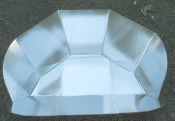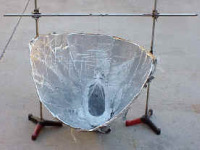Passive Cooling
Here are three methods of alternative refrigeration you can use without electricity. Your best success will come using a combination of all three passive cooling methods.
Having a way to refrigerate your food and “chill out” when the power goes out could be one thing to help ease the stress during a crisis.
Solution 1: Evaporative Cooler Fridge

Supplies needed:
- A shelf unit
- Burlap bags
- Clamps or clothespins
- Large pan for water (if needed)
- A cheap PVC shelf unit from you local hardware store works well. It’s lightweight and inexpensive.
Assembling Instructions:
- Assemble shelf with the top shelf inverted (shown in picture) to use as a built-in tray for water.
- Cut burlap to fit around shelf. I recommend doing this ahead of time in case you need to sew pieces together.
- Soak burlap in water and place around shelf as shown using the clamps or clothespins to hold cloth in place.
- Fill the top (or large pan/cookie sheet) with water.
- Leave an extra amount of burlap folded over on the top to soak in the water.
Putting it in the shade is of course optimal and a slight breeze is helpful too.
One year when I was at a family reunion in Pinedale, AZ during the summer, we used this alternative refrigeration method to keep our things cool because there was a short supply of ice for coolers. It worked VERY well.
Solution 2: Zeer Pots
Supplies needed:
- 2 clay pots that are able to nest inside of each other (round pots work best). They need to be clay/earthenware and MUST be unglazed.
- Sand-- enough to fill in the space between the 2 pots
- A piece of burlap or thick blanket

Mohammed Bah Abba of northern Nigeria won a Rolex Award for his pot-in-pot invention. It is a refrigerator than runs without electricity. “A key reason for the pot-in-pot’s success is the lack of electricity in most of the northern rural communities, for without electricity there can be no refrigeration.”
This alternative refrigeration method is being used in Third world countries to help fresh produce last longer.
Here's how it works. You take a smaller pot and put it inside a larger pot. Fill the space in between the two pots with wet sand. Cover the pots with a wet cloth. When the water evaporates, it pulls the heat out with it. This simple alternative refrigeration unit uses basic laws of physics to keep the inner vessel cool.
Solution 3: Radiant Fridge

This is a fabulous way to sometimes actually MAKE ice at night in the same item that you used during the day to cook your food! You can then use the ice to cool things during the day. The only problem with this option is that it requires you have to have a clear NIGHT to work.
Set it up like a solar oven. The same rules apply. Just put the jar or pan with a bag around it with the water inside. The air is concentrated into the container just like the sun is during the day. In the morning you have ice, or at the least you can put an item that needs to keep cool inside the pot so that the temperature can be colder during the night.
Two Examples Radiant Cooling
How to Use the Solar Funnel as a Refrigerator/Cooler
Here’s an excerpt from the writing of Steven Jones, a retired physics professor.

“Funnel Cooker can be used - at night - as a refrigerator. Here is how this is done.
The Solar Funnel Cooker is set-up just as you would during sun-light hours, with two exceptions:
- The funnel is directed at the dark night sky. It should not "see" any buildings or even trees. (The thermal radiation from walls, trees, or even clouds will diminish the cooling effect.)
- It helps to place 2 (two) bags around the jar instead of just one, with air spaces between the bags and between the inner bag and the jar. HDPE and ordinary polyethylene bags work well, since polyethylene is nearly transparent to infrared radiation, allowing it to escape into the "heat sink" of the dark sky.
During the day, the sun's rays are reflected onto the cooking vessel which becomes hot quickly. At night, heat from the vessel is radiated outward, towards empty space, which is very cold indeed (a "heat sink").
As a result, the cooking vessel now becomes a small refrigerator. We routinely achieve cooling of about 20º F (10º C) below ambient air temperature using this remarkably simple scheme.”
Using a Solar Oven as a Radiant Refrigerator at Night

Richard McMahon of Western Australia
He used a box cooker to make ice. The “Uncooker” was placed in a location where it saw a maximum amount of sky and no trees or buildings. He was getting ice in the cooker even though the outside temperature was above freezing. During the summer months he was unable to make ice.
Later he built a radiant refrigerator. During the summer months the temperature inside the fridge would not rise above 16° C. Read More . . .
Source : http://www.provident-living-today.com/Alternative-Refrigeration.html